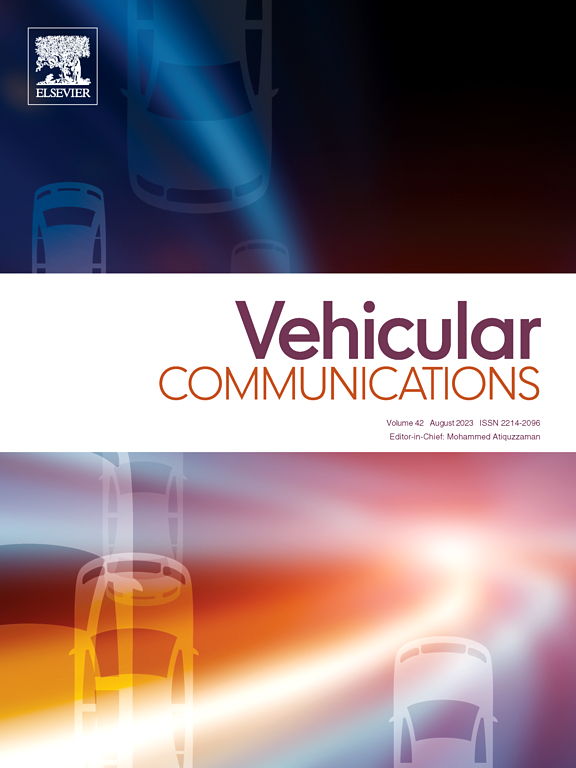Rigid communication topologies: Impact on stability, safety, energy consumption, passenger comfort, and robustness of vehicular platoons
IF 6.5
2区 计算机科学
Q1 TELECOMMUNICATIONS
引用次数: 0
Abstract
This paper investigates the impact of rigid communication topologies (RCTs) on the performance of vehicular platoons, aiming to identify beneficial features in RCTs that enhance vehicles behavior. Four performance metrics are introduced, focusing on safety, energy consumption, passenger comfort, and robustness of vehicular platoons. The safety metric is based on momentary distances between neighboring vehicles, their relative velocities, and relative accelerations. Thus, to have access to these relative values, the coupled dynamics between pairs of neighboring vehicles are formulated, considering initial conditions (position, velocity, acceleration), the velocity/acceleration trajectory of the leader vehicle, deployed RCT, and the parity/disparity between vehicles. By decoupling the dynamics using a mapping matrix structured on deployed RCT, the features of the vehicles, and control gains, precise formulations for distance errors, relative velocities, and relative accelerations between all neighboring vehicles, over the travel time, are obtained. Comparing performance metric results across RCTs highlights that downstream information transmission—from vehicles ahead, particularly the leader vehicle, to vehicles behind—significantly enhances platoon stability, safety, energy consumption, and passenger comfort metrics. Conversely, receiving state information from vehicles behind degrades metrics, compromising safety, increasing energy consumption, and reducing passenger comfort. These findings underscore that forward-looking, leader-centric communications between vehicles markedly enhance platoon efficiency and safety.
刚性通信拓扑:对车辆队列稳定性、安全性、能耗、乘客舒适度和鲁棒性的影响
本文研究了刚性通信拓扑(rct)对车辆队列性能的影响,旨在识别rct中增强车辆行为的有益特征。介绍了四个性能指标,重点是安全性、能耗、乘客舒适度和车辆队列的鲁棒性。安全度量是基于相邻车辆之间的瞬时距离、它们的相对速度和相对加速度。因此,为了获得这些相对值,考虑初始条件(位置、速度、加速度)、领先车辆的速度/加速度轨迹、部署RCT以及车辆之间的宇称/视差,制定了相邻车辆对之间的耦合动力学。通过使用基于部署RCT的映射矩阵解耦动力学、车辆特征和控制增益,获得了所有相邻车辆在行驶时间内的距离误差、相对速度和相对加速度的精确公式。对比rct的性能指标结果可以发现,下游信息传输——从前车,特别是领先车辆,到后车——显著提高了车队的稳定性、安全性、能耗和乘客舒适度指标。相反,从后面的车辆接收状态信息会降低指标,影响安全性,增加能源消耗,降低乘客舒适度。这些发现强调,车辆之间前瞻性的、以领导者为中心的通信显著提高了排的效率和安全性。
本文章由计算机程序翻译,如有差异,请以英文原文为准。
求助全文
约1分钟内获得全文
求助全文
来源期刊

Vehicular Communications
Engineering-Electrical and Electronic Engineering
CiteScore
12.70
自引率
10.40%
发文量
88
审稿时长
62 days
期刊介绍:
Vehicular communications is a growing area of communications between vehicles and including roadside communication infrastructure. Advances in wireless communications are making possible sharing of information through real time communications between vehicles and infrastructure. This has led to applications to increase safety of vehicles and communication between passengers and the Internet. Standardization efforts on vehicular communication are also underway to make vehicular transportation safer, greener and easier.
The aim of the journal is to publish high quality peer–reviewed papers in the area of vehicular communications. The scope encompasses all types of communications involving vehicles, including vehicle–to–vehicle and vehicle–to–infrastructure. The scope includes (but not limited to) the following topics related to vehicular communications:
Vehicle to vehicle and vehicle to infrastructure communications
Channel modelling, modulating and coding
Congestion Control and scalability issues
Protocol design, testing and verification
Routing in vehicular networks
Security issues and countermeasures
Deployment and field testing
Reducing energy consumption and enhancing safety of vehicles
Wireless in–car networks
Data collection and dissemination methods
Mobility and handover issues
Safety and driver assistance applications
UAV
Underwater communications
Autonomous cooperative driving
Social networks
Internet of vehicles
Standardization of protocols.
 求助内容:
求助内容: 应助结果提醒方式:
应助结果提醒方式:


